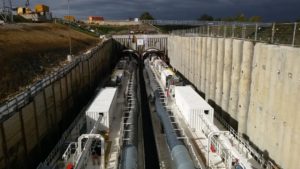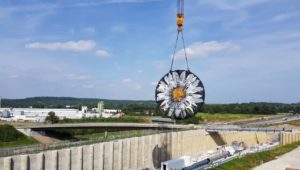January 2020
Albvorland Tunnel – Connecting Alb to Stuttgart
The Albvorland Tunnel is 8.1 km long and is part of Section 2.1 A/B of the Alb Foothills Connection to Stuttgart Rail Node project and comprises a twin bore of two single-track tunnels running almost on the same level. The site is part of one of the largest construction projects currently underway in Germany.
 The two LDT (Large Diameter Tunnelling) single track drives were driven using Herrenknecht EPB machines to a diameter of 10.82 m by contractor Implenia. Both the tunnels had in the design minimum bend radii of 3,986 m. Tunnelling works started in October 2017 with the final breakthrough of the second tunnel occurring in October 2019 with a peak performance in advance of up to 200 m per week.
The two LDT (Large Diameter Tunnelling) single track drives were driven using Herrenknecht EPB machines to a diameter of 10.82 m by contractor Implenia. Both the tunnels had in the design minimum bend radii of 3,986 m. Tunnelling works started in October 2017 with the final breakthrough of the second tunnel occurring in October 2019 with a peak performance in advance of up to 200 m per week.
Supporting the tunnelling equipment, VMT provided several product lines including:
- TUnIS Navigation TBMLaser guidance system
- TUnIS Navigation Office – which provides real-time navigation and ring data from one or more TBMs thereby allowing the navigation system to be directly monitored from the site office.
- TUnIS Ring Sequencing – which automatically calculates the optimum ring sequence for tunnel advances using segmental lining.
- SDS.Production (Segment Documentation System SDS) – segment production module module which supports production planning and ensures compliance with defined quality and documentation standards for both stationary or carousel segment production options.
- Ring Convergence Measurement System RCMS – which monitors movement in the support rings as tunnel advance continues.
- Laser Tracker Industrial Measurement System LIS – Service for segment and mould measurements during the complete production time of segments
 Whilst most of these products have a well-established reputation in the tunnelling industry, one the VMT’s major challenges for the Stuttgart-Ulm project was the development of the automated RCMS product. With the site close to VMT’s main offices, there was the advantage, that during development and with the close cooperation of the client and contractor, VMT was able to field test various hardware and software aspects of the product during the development phases.
Whilst most of these products have a well-established reputation in the tunnelling industry, one the VMT’s major challenges for the Stuttgart-Ulm project was the development of the automated RCMS product. With the site close to VMT’s main offices, there was the advantage, that during development and with the close cooperation of the client and contractor, VMT was able to field test various hardware and software aspects of the product during the development phases.
This was advantageous to both parties in that VMT has made developments to its basic product that are now applicable to segmental tunnelling projects worldwide and the Stuttgart client and contractor have precisely the right product that suits their requirements for the future operation of the tunnels.
According to Dipl.-Ing. Thomas Unterfeld, Measurement Coordinator for Implenia Construction GmbH Tiefbau – Tunnelbau Deutschland: “We were extremely pleased with the modifications to the basic RCMS system provided by VMT to ensure our system fitted our purpose exactly. Would we use RCMS again? Yes, most definitely, particularly as it would partner us again with the VMT team.”
At a Glance Fact Sheet:
|
